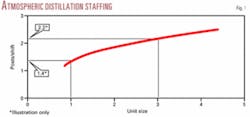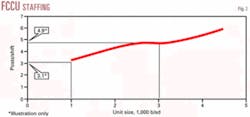Montreal refinery staffing analysis
Petro-Canada's Montreal refinery is complex for a relatively small plant. The 105,000-b/cd refinery is configured with parallel processing units. The design and complexity of this refinery significantly complicates the task of setting staffing targets.
The Solomon analysis team knew it would need to justify to senior Petro-Canada management any target that was less than first quartile. In addition, to make any sustainable change in refinery staffing, Solomon would need to convince the refinery operating staff and labor union officials that targets were both reasonable and safe.
Solomon began the staffing analysis by separating the staffing numbers into two components: posts/shift and equivalent personnel/post (see table above).
Benchmarking revealed that the Montreal refinery had nearly the same number of people/process unit operating position (post) as the peer groups but had significantly more posts/shift. The number of posts in the refinery determined the staffing figures. The team suspected that the refinery configuration established this staffing level and began to examine the effect of the refinery's parallel configuration.
Solomon used its database to review "economies of scale" for individual process unit staffing for atmospheric crude distillation and FCC process units (Figs. 1 and 2).
null
Fig. 1 shows a significant economy-of-scale effect in atmospheric distillation staffing. An atmospheric distillation unit of size 1 has 1.4 posts/shift, and an atmospheric distillation unit of size 3 has 2.2 posts/shift. If a refinery were to have three size-1 units equaling the capacity of one size-3 unit, staffing would be three times 1.4 or 4.2 posts/shift.
Fig. 2 shows a similar correlation for FCCU staffing. All conversion units have a higher baseload staffing than atmospheric distillation. The same example of three small units totaling the same capacity of one large unit results in three times 3.1 or 9.3 posts/shift vs. 4.9 for the single larger FCCU.


